Application of the Irene's Donuts Method (Innovative UKGS) in Reducing Caries Risk Scores in Children at Al-Bayan Integral Elementary School
DOI:
https://doi.org/10.32382/mkg.v22i1.20Keywords:
Irene's Donuts; , caries; , behaviorAbstract
Caries is the most common disease faced by people in the world. Tooth decay is caused by excessive sugar intake, a lack of dental care, and difficulty accessing standard dental services. Irene's Donuts is a computer program created by Dr. Drg. Irene Adyatmaka that can now be launched using a smartphone thanks to modern technological advances. The program will display a big picture of a child's risk for the possibility of dental caries by filling in the risk factors related to the child's behavior, the condition of the child's dental health, the environmental conditions of the mother and child, knowledge, attitudes, and behavior. This study aims to determine the application of the Irene's Donuts (Innovative UKGS) method in reducing caries risk scores in children at Al-Bayan Integral Elementary School. This study used quantitative data analysis, namely univariate analysis. The sample in this study was obtained using the stratified sampling technique, totaling 69 students. Methods of data collection by way of observation using a questionnaire sheet. The results of the study show that the Irene's Donuts method can reduce the caries risk score by applying, giving efforts, and offering anticipation that can be done at home.
Keywords : Irene's Donuts; caries; behavior
Downloads
Published
How to Cite
Issue
Section
License
Copyright (c) 2023 Asridiana, Nurwiyana Abdullah, Fakhirah Mentari Febryana, Agus Supriatna

This work is licensed under a Creative Commons Attribution-ShareAlike 4.0 International License.
The authors retain copyright and grant Media Kesehatan Gigi journal the right of first publication with the work simultaneously licensed under a Creative Commons Attribution-ShareAlike 4.0 International License, which allows others to share the work with an acknowledgment of the work's authorship and initial publication in this journal.
.pdf downloaded: 356






